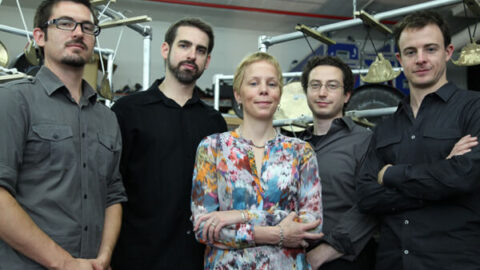 Third Coast Percussion gave the world premiere of Resounding Earth by Augusta Read Thomas, at DeBartolo Center for the Performing Arts at Notre Dame University on Sunday, September 30, 2012. This major new addition to the percussion repertoire was passionately and precisely rendered by ensemble members Owen Clayton Condon, Robert Dillon, Peter Martin, and David Skidmore.
Third Coast Percussion gave the world premiere of Resounding Earth by Augusta Read Thomas, at DeBartolo Center for the Performing Arts at Notre Dame University on Sunday, September 30, 2012. This major new addition to the percussion repertoire was passionately and precisely rendered by ensemble members Owen Clayton Condon, Robert Dillon, Peter Martin, and David Skidmore.
Resounding Earth has its origins deep in human history. Since humans learned to smelt and ore metals about 5,600 years ago, we have been making bells. Bells have been an essential instrument of human culture in virtually every culture and civilization around the globe. The use of bells is as prosaic as marking time, and as solemn as signifying rites of passage and transformation in religious and cultural ceremonies. Consequently, bells and bell-like instruments have found their way into many diverse global music traditions.

In Resounding Earth, Thomas grapples with this cultural depth and weight of bells, calling the piece a “United Nations of Resonances.” Working in close collaboration with Third Coast she has constructed a piece for a palette of over 300 bells and other resonant metal objects and a slew of mallets and strikers. From the opening clang, the commitment and energy Thomas, Condon, Dillon, Martin, and Skidmore have invested in developing Resounding Earth was crystal clear. The piece unfolded in four sections, each with its own unique rhythmic and timbral character.
Section 1. Invocation – Pulse Radiance began at a rousing pace, with each player striking a wide range of bells, gongs, bowls, plates, triangles, and metal spirals. They played complex sequences with precision and grace in overlapping contrapuntal patterns that passed around the stage from player to player. The stunning acoustics of DeBartolo’s Leighton Concert Hall provided an ideal environment for the astounding eerie resonances and long decays of many of the bells.
In Section 2. Prayer – Stardust Orbits, the players moved to tables containing 26 Rin prayer bowls and 10 crotales. The music in this section unfolded in a slow, ritualistic, elegiac manner. The players alternated between striking the bowls and crotales and rubbing mallets around the edges of the bowls. The effect was mesmerizing, literally inducing a trance-like state.
For Section 3. Mantra – Ceremonial Time Shapes, Third Coast played a battery of 18 Burma bells, 10 Noah bells, and 6 gongs. The Burmas are flat bells in varying sizes with a unique quality of sounding different when struck on different areas of the surface, adding to the precision required by the players. The players set the Burma bells spinning as they struck them, amplifying the sound and adding a visual element as the whirling bells reflected the stage lights. The ability of the Third Coast members to play this complex section in lock-step synchronization with very limited eye contact was astounding.
The finale, Section 4. Reverie Carillon – Crystal Lattice, required the players to engage with all the instruments from the previous sections. The spacing of bell strikes became far more sparse, with even more emphasis on the long decays of the various bells. Ultimately, the piece slowly drifted into silence
Photos by Kirk Richard Smith and Tadashi Omura, with kind permission. All rights reserved.
Resounding Earth is a celebration of the bell in human culture which resonates across the ages and around the world. It engulfs and overwhelms the listener in its tingling sound world. Third Coast Percussion attacked the piece with tightly coordinated striking and choreographed movements, which were enhanced for the audience by video projections from overhead cameras. The year-and-a-half long investment by Thomas and the ensemble paid off in a bravura performance of an important new percussion work. It is unclear how big a challenge another ensemble would face to master Resounding Earth, but for them and their audiences it would be well worth it.
Resounding Earth formed the second half of a concert that also featured ardent readings of Condon’s Fractalia for two marimbas and drums; Steve Reich’s Mallet Quartet for two concert grand marimbas and two vibraphones; and John Cage’s Third Construction for a panoply of standard instruments, household items, and a conch shell.
Sunday’s concert was the culmination of a weeklong residency by Third Coast Percussion and Thomas. Much of their focus was on interacting with Notre Dame science, engineering, and arts faculty in a program to improve the teaching of math and science in local schools. Not content with the standard approach to promote STEM (Science, Technology, Engineering, Math), they have added the Arts, expanding the program to encourage STEAM learning. The quartet also recorded Resounding Earth in Leighton Concert Hall during the week. CD and DVD versions will be released sometime in the next few months.
[Watch Third Coast Percussion at MoMA, an I CARE IF YOU LISTEN Video…]
—
Arlene and Larry Dunn are pure amateurs of contemporary music. Visit their blog at Acornometrics and follow them on Twitter: @ICEfansArleneLD
























